When a bubble is not a bubble
Looking at the charts of Asian markets, they immediately scream 'bubble' - spectacular gains that must surely be followed by a fall. But the charts don't tell the whole story. Cris Sholto Heaton looks back at the history of Asian markets to give a new perspective on the continent's booming stockmarkets.

After I wrote about Indonesia last time, a reader said that he had one major concern. The chart of the Jakarta stockmarket looked disturbingly like a bubble. And in many ways I agree. Looking at long-term charts of Asian markets, I often have the same sense. The gains of the last few years look far too big to be genuine. Rises like these must be followed by a fall at some point.
But is that impression fair? Have Asian markets really come too far too fast? Or do the charts not tell the whole story? This week, I'm going to delve into history, going back further than the five or ten years that most investors tend to focus on. You may well not have seen most of these charts before. I hope they at least give you a new perspective on the Asian boom.
Why the Indonesian market is soaring
Let's take that Indonesia chart again as the first example. It's pretty clear why everyone's first impulse is "that's a bubble".
MoneyWeek
Subscribe to MoneyWeek today and get your first six magazine issues absolutely FREE

Sign up to Money Morning
Don't miss the latest investment and personal finances news, market analysis, plus money-saving tips with our free twice-daily newsletter
Don't miss the latest investment and personal finances news, market analysis, plus money-saving tips with our free twice-daily newsletter
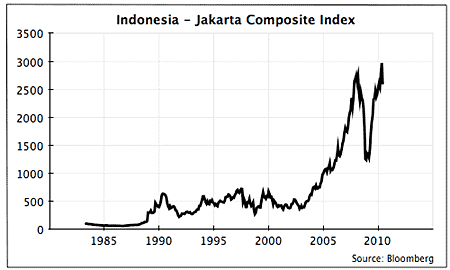
But what's the context here? We must remember that in most of emerging Asia, stock markets haven't been established for very long compared with the developed world.
There's been some organised trading in most countries since the late 1800s or early 1900s. But in most cases, it's been interrupted by wars, revolutions, a running aversion to capitalism, or a simple lack of interest.
Dutch colonists first opened an exchange in Indonesia in 1912. It was closed and reopened several times before the current market was established in 1977. The Jakarta Composite Index chart above starts from 1983. It's the longest series I've been able to find data for emerging markets stretching back more than a couple of decades is patchy.
The 1980s and early 1990s cover a period of strong growth and increasing international investment, but also worsening corruption, crony capitalism, growing levels of corporate debt and irresponsible lending by the banks. Then the Asian crisis hit in 1997.
The rupiah which was pegged to the dollar was devalued enormously. The economy collapsed into a severe recession. GDP fell by 13%. Corporate bankruptcies soared, made worse by huge foreign-currency debts. The banking system was insolvent and had to be bailed out. Hundreds died in riots and the country's dictatorial president Suharto was forced to leave office after 32 years. Hyperinflation took hold.
Many investors lost their shirts. And those who hadn't wouldn't go near the country. So the market languished and of course, the result in real terms was much worse than the chart suggests.
It took until the middle of the last decade for reforms to have gone far enough, the economy to have become solid enough and for memories of the crisis to have faded enough that investors would return.
This turnaround goes a long way to explaining why Indonesia may look like a bubble. Yet even after the recent surge, the market still trades on a forecast price/earnings ratio of around 13.2 times next year's estimated earnings. That's only possible because five years ago it was coming off an extremely low base.
Ups and downs everywhere
We see a similar pattern in many other Asian markets. In many cases, their markets were unsophisticated or unpopular until relatively recently.
Consider China. A stock exchange first opened in Shanghai in 1891. In the early 1950s, it was closed after Mao's communists set about eradicating capitalism. One legend, which I've never been able to confirm, is that stocks had rallied sharply after the Kuomintang government lost the civil war and fled to Taiwan in 1949, on the basis that the upheaval was about to end. If so, it was possibly the worst market forecast of all time.
Two new mainland stockmarkets were finally re-established in Shanghai and Shenzhen in 1990. Since then it's been up and down, to say the least. This market clearly peaked in a bubble in 2007 on a p/e of over 50.
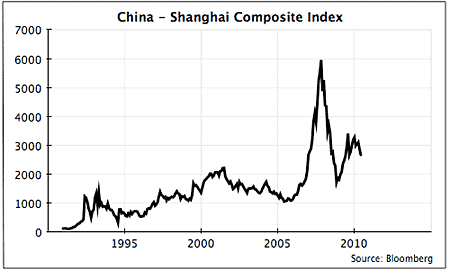
Since then it has been following the classic post-bubble pattern. I'd expect it to trace out several rallies and troughs before another bull market can begin. (Remember this is the domestic A-share market in which few foreigners can invest. It's not necessarily the same thing as any China investments you hold, which are usually Hong Kong listed.)
Expert tips & advice for investing in Asia! Claim your FREE guides from MoneyWeek that include:
- How to go about investing to Asia
- Which brokers to use to buy foreign shares
Meanwhile, India has had a stock exchange since around 1875. But under a statist government and the 'licence raj' that made competitive capitalism difficult, it was relatively unimportant. It was only after reforms were obviously paying off in the mid-2000s that the India boom really got underway.
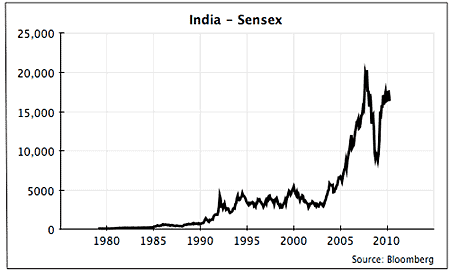
Meanwhile, Vietnam had never had a stockmarket prior to 2000. So it's no surprise that it kicked off with an immediate boom and bust and an even bigger one a few years later.
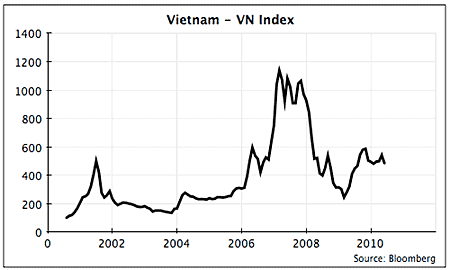
Part of these ups and downs in the early stages are about volatile earnings and economies. But part of it is about unsophisticated markets full of gamblers rather than investors, leading to easy bubbles.
Swings in interest from foreign investors, who can command a huge amount of money relative to the market size, are also a factor. And don't overlook the significance of inflation. Many emerging economies have high inflation or periods of hyperinflation, which can make moves look far more dramatic than they really are.
More advanced markets don't behave like this
Still, not all Asian markets have behaved like this over the last couple of decades. Markets such as Hong Kong, Singapore and Malaysia may not have been established earlier than most of the others. But they've had a longer, less interrupted culture of capitalism.
And economically they are much further ahead than most of the region. Hong Kong and Singapore are developed countries, only classed as emerging Asia for historical reasons and because of their close links with their neighbours.
As a result, while they've been volatile, they show a fairly consistent upward trend over the three to four decades for which we have consistent index data. Overall, they look much more reassuring than the charts above.
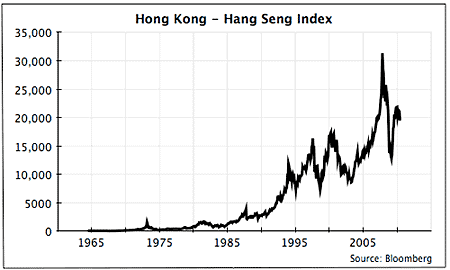
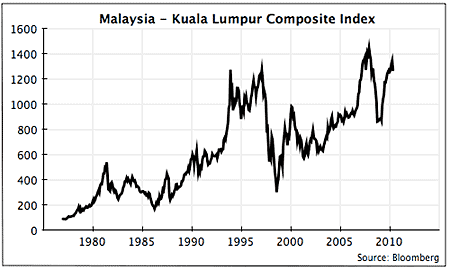
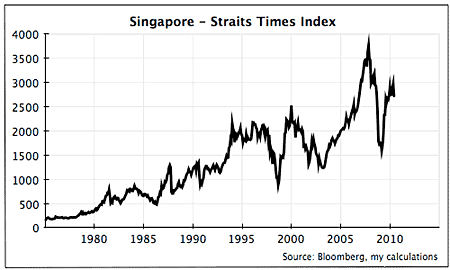
A few lessons from history
So what lessons can we take away from this? For one, it reinforces how volatile emerging markets can be. That's the kind of thing that crops up on investment warnings all the time. But it's only after seeing the hard numbers that one can appreciate what that means.
But another is that with early stage markets, appearances can very deceptive. It might be a bubble. Or it might be investors suddenly returning to a very depressed market. With many emerging markets there will come a point when they suddenly shift gear when the stock market becomes much more relevant, reflective of what's going on in the economy, and worth investing in.
That will often mean a quick adjustment. Sometimes that will go too far and end up as a monster bubble. But sometimes it will be a rapid step-up, often followed by a quick correction that will still look a reasonable place to have invested in hindsight. The charts of Singapore, Malaysia and Hong Kong above show a fair share of both types if you look at them closely.
A third lesson is that bubbles can be a lot less troublesome that you might think. Take Taiwan at the end of the 1980s. This remains one of the most impressive bubbles I've ever seen. Through two decades of consistent 9% growth, the market had idled along and then it exploded.
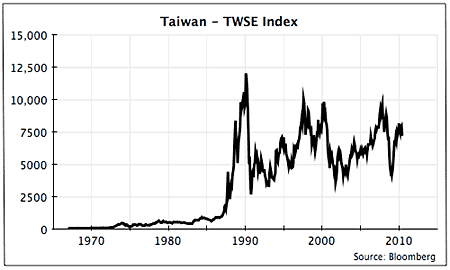
It's a great example of how a mania can suddenly take hold, dragging everyone along with it. At the peak, there should have been no doubt that this was a bubble. The market price/earnings was around 100. But no-one was concerned with valuation. This was gambling, pure and simple.
What was doubly interesting was the aftermath. The Wall Street crash of 1929 and the bursting of Japan's bubble (which happened at the same time as Taiwan's bust) were followed by the great depression and by two decades of stagnation respectively. As a result, we tend to assume that any big bubble and bust has the same effects.
Yet Taiwan kept growing at a rapid pace for several more years. The fact that growth has now slowed sharply has everything to do with competition from the mainland and the slower rate of growth that's natural in a wealthy economy.
And those who subsequently bought when valuations were lower made good if volatile long-term returns. It's not really boom and bust we need to fear it's buying in at the peak.
Asia is fair value but that doesn't mean things will run smoothly
Taking the MSCI Asia ex-Japan as a broad proxy for the region as a whole, it currently stands on 442 at a price/book value of 1.72, which is in line with its long-term average.
As regular readers know, I find price/book a useful metric for assessing the overall Asian market because a) we have a good long-term data series; b) it's not affected too much by short-term swings in earnings; and c) it shows a strong pattern of boom and bust around a stable long-term average.
All of this shows up clearly in the chart below.
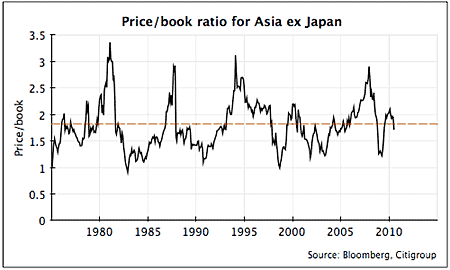
From these kind of levels, a respectable long-term return of around 7-8% (after inflation) looks likely. That's plausible based both on typical historical returns from these levels and on theory: with a long-run average return on equity (i.e. book value) of 12% and us paying 1.7 times book value, we'd expect a return on our investment of 12%/1.7=7%.
That said, this tells us nothing about what will happen in the short run. The eurozone panic has led to a widespread sell-off; that could go further. Alternatively, we could head into an emerging markets mania within a couple of years. Or we could face a few years of choppy trading, nudging steadily higher.
But as long as we're not paying stupid prices, our long-term returns should still be good regardless of what happens in the short run. And while I see a few markets in Asia that have come a long way and could be vulnerable to a pullback on any disappointment and Indonesia could be one they're not priced like a bubble.
So right now, I'm not too worried about what the charts look like. When the mania next takes hold and we're trading on 40 times earnings well, that will be a different story. But I think we're still a few years away from that.
This article is from MoneyWeek Asia, a FREE weekly email of investment ideas and news every Monday from MoneyWeek magazine, covering the world's fastest-developing and most exciting region. Sign up to MoneyWeek Asia here
Get the latest financial news, insights and expert analysis from our award-winning MoneyWeek team, to help you understand what really matters when it comes to your finances.
Cris Sholto Heaton is an investment analyst and writer who has been contributing to MoneyWeek since 2006 and was managing editor of the magazine between 2016 and 2018. He is especially interested in international investing, believing many investors still focus too much on their home markets and that it pays to take advantage of all the opportunities the world offers. He often writes about Asian equities, international income and global asset allocation.
Cris began his career in financial services consultancy at PwC and Lane Clark & Peacock, before an abrupt change of direction into oil, gas and energy at Petroleum Economist and Platts and subsequently into investment research and writing. In addition to his articles for MoneyWeek, he also works with a number of asset managers, consultancies and financial information providers.
He holds the Chartered Financial Analyst designation and the Investment Management Certificate, as well as degrees in finance and mathematics. He has also studied acting, film-making and photography, and strongly suspects that an awareness of what makes a compelling story is just as important for understanding markets as any amount of qualifications.
-
 The shape of yields to come
The shape of yields to comeCentral banks are likely to buy up short-term bonds to keep debt costs down for governments
-
 The sad decline of investment clubs – and what comes next
The sad decline of investment clubs – and what comes nextOpinion Financial regulation and rising costs are killing off investment clubs that once used to be an enjoyable hobby, says David Prosser
